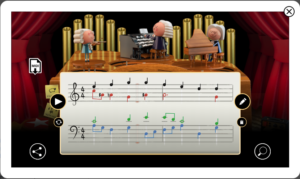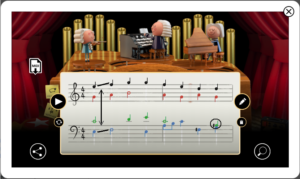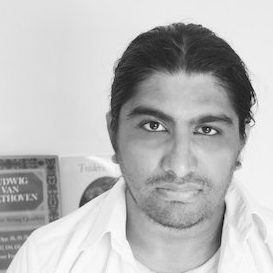Georg Philipp Telemann was a contemporary of Johann Sebastian Bach, and along with George Frideric Handel made up the “holy trinity” of German Baroque composers.However, his music has not been studied much, either by music scholars, or those in other fields. This project aims to rectify this, through an interdisciplinary study of his corpus of 430 chorale compositions. But the project has a larger goal as well. Chorales—especially those by Johann Sebastian Bach—have been central works of classical music, both in the performance repertoire, and in their use in the academy, to study musical structure, and to teach this to students. But Bach’s chorales are complex masterworks, and their prevalence in performance and scholarship have come under increased scrutiny in recent years. For example, students often find them difficult, and as a result many have questioned their use in the classroom, compared to other, more accessible, repertoires. They have also been the focus of many research projects, including Google’s much–publicized Magenta initiative, which models Bach’s musical language on them—but rather unsuccessfully, again due to their complexity. Therefore, the proposed Telemann Chorale project aims to overcome some of these performance, pedagogical, and scholarly challenges, by focusing on a different chorale repertoire, viz., Telemann’s 430 chorales. Telemann’s chorales are simpler than Bach’s, meaning that they can be used to rehabilitate the chorale as a teaching resource in the classroom, and can be used more effectively to model musical structure as well.
The plan for this project is to develop a UARTS Faculty Engineering/Arts Student Team (FEAST) to work on a new edition of Telemann’s chorale book with his 430 chorales (i.e., the Fast Allgemeines Evangelisch–Musicalisches Lieder–Buch, whose most recent edition is from 1730). This will involve developing (1) score recognition technologies, to automatically transcribe the 1730 edition into machine code, and (2) a computational model that can generate the four parts of these chorales (i.e., soprano, alto, tenor, bass) from the code of the 1730 edition (which only contains soprano and bass parts). All of this will require blending ideas from music theory and performance with ideas from the computational and cognitive sciences—the end result of this being a modern, performing, edition of the chorales, which can be used by musicians, and which will serve as a pedagogical resource for music teachers as well, especially those who want an alternative to the Bach chorales. But perhaps more significantly, it will provide a model for how musical structure is generated, which is a central question within music theory and the cognitive science of music—and which will provide a direct response to other attempts to model this structure, not only within the academy, but outside it as well (e.g., at Google).
Though long neglected in comparison to his more illustrious contemporaries Bach and Handel, Telemann’s music is seeing a revival these days. (For example, see this reference, which came out earlier this year.) This resurgence of interest in Telemann’s music gives us a chance to create new editions of his works, which have been long neglected as well. His 430 chorales, for examples, have not been re–published since 1730. This project will, therefore, develop a new edition of these chorales, which will be a major addition to the repertoire of Baroque vocal music, for performers to sing and for scholars to study. To develop this edition, this project will use ideas from music theory, computer science, and related disciplines (such as linguistics and cognitive psychology) to understand how Telemann created these chorales—and how, therefore, a computational model of Telemann’s music can re-create them, quickly and automatically, to generate this new chorale edition. In other words, the project will try to ‘get into’ Telemann’s mind, to understand his creative process and the musical language he used to compose these chorales.
This interest in simulating a composer’s creative processes, especially in Baroque vocal music, has attracted a variety of researchers for quite some time now. For example, researchers in Google’s Magenta project have been trying to simulate how Bach composed his chorales. Part of this was released as a Google ‘doodle’ on his birthday, March 21, last year. You can enter a two-bar melody into this doodle, and Magenta’s simulation will output a short chorale fragment (in four voices, i.e., soprano, alto, tenor, and bass) subsequently. But these past attempts to model Baroque vocal music, including those being done within the Magenta project, often do not even come close to illustrating how composers actually wrote music. For example, if you enter the first two bars of Bach’s most famous chorale tune “Werde munter, mein Gemüte” (known better through his arrangement “Jesu, Joy of Man’s Desiring”) into the Google doodle, this is one of the two-bar chorale fragments the doodle outputs.


This simulation begins in the right key, but with what is known as a first-inversion chord, since this chord is a C-major chord with E in the bass. This E moves to F on beat 2—but so does the soprano melody, leading to what are called “parallel octaves,” which is a compositional error Bach would have never made, at least not in this way. (You can see such parallel octaves between thebass and the soprano on beats 2 and 3 of the first image too, between F and G.) This simulation also ends on a G-minor chord, instead of a G-major one, as you can see in the circled A# (which is really a Bb) in the tenor voice (in green) of the last chord.
In contrast, see below Telemann and Bach’s own realization of the first two bars of this chorale:

Telemann

Bach
So, there needs to be a better way of modeling these pieces and avoiding mistakes in their simulations of the kind not found in the original composition. As the project will illustrate, this requires ideas from music theory, and the other aforementioned disciplines, to simulate the kinds of theoretical knowledge composers such as Telemann and Bach had, which allowed them to write the music they did. Therefore, modeling the vocal music of these composers not only allows us to make better, newer, editions of their works, it provides a window into how music is structured, and how human minds process musical information creatively, to produce these structures.
But as we see from the above examples too, Bach’s chorale compositions were often a bit more complex than those of Telemann. So, to model Baroque chorale–style vocal music, it might be better to start with Telemann’s works first, instead of focusing one’s study on the more complex structures of Bach from the outset (as has been the case with Magenta and other projects). This, therefore, is the goal of this FEAST project too—to focus on Telemann’s music, not only to revitalize an interest in this composer’s works, through a new edition of his chorale compositions, but to use his music as a stepping stone to a larger study of how the musical mind works, how it processes musical information to create new musical structures, and how all this tells us more about the richly–structured language that is music.
Meeting Details
Thursdays, 5:00-7:00pm
Modality: In-person (interested in the project but unable to be on campus? Contact us to inquire!)
Students apply to a specific role on team as follows:
Music Theory (4 Students)
Preferred Skills: Basic set of skills in harmonic and contrapuntal theory and analysis, especially with Baroque music
Likely Majors/Minors: THEORY, COMP, PIANO, MUSICOL
Cognitive/Computational Science (4 Students)
Preferred Skills: Knowledge of natural language processing techniques, optical recognition technologies, generative grammars
Likely Majors/Minors: CS, EE, CE, SI, LING, PSYCH, COGSCI, NEUROSCI
Faculty Lead
 Ramon Satyendra holds a doctorate from the University of Chicago in music theory and history. Before coming to Michigan, he taught at Yale University and the University of Chicago. He currently serves on the editorial boards of The Journal of Mathematics and Music, Intégral, and Analytical Approaches to World Music.
Ramon Satyendra holds a doctorate from the University of Chicago in music theory and history. Before coming to Michigan, he taught at Yale University and the University of Chicago. He currently serves on the editorial boards of The Journal of Mathematics and Music, Intégral, and Analytical Approaches to World Music.
Highlights of previous service to the field include Executive Committee of the Society of Music Theory, the editorial board of Music Theory Spectrum, and editor of the Journal of Music Theory. Among his awards are the Merten Hasse Award in Mathematics from the Mathematical Association of America and the Clauss Prize for Teaching Excellence in the Humanities from Yale University. He is a three-time fellow of the Mannes Institute for Advanced Studies in Music Theory. Satyendra’s research interests include music and mathematics, late nineteenth-century music, jazz, South Asian music, and compositional theory. He plays piano, organ, tabla, and guitar and has published in Music Theory Spectrum, Music Analysis, Journal of Music Theory, American Mathematical Monthly, and elsewhere.
Project Collaborator
 Sam Mukherji‘s work lies at the interface of traditional Western tonal theory, the theory and practice of popular and non-Western idioms, and the cognitive science of music. Within this framework, the main focus of his research has been on the prolongational, grammatical aspects of Western tonality and their connection to the tonal structures of Indian music and the blues-based traditions within rock and metal. This emphasis makes his work similar to that of a linguist who explores relationships between the world’s languages—and, therefore, Mukherji’s research has been influenced in particular by ideas from linguistic theory, especially the Minimalist Program in contemporary generative linguistics. For this reason, he has investigated connections not only between different musical idioms but also between music and language –and musical and linguistic theory—more generally. Much of his work explores overlaps between Minimalist linguistics, and related, generative approaches within music theory (such as those found in the writings of Heinrich Schenker), and he has also written extensively about what such “musicolinguistic” connections imply for the wider study of human musical behavior, cognition, and evolution.
Sam Mukherji‘s work lies at the interface of traditional Western tonal theory, the theory and practice of popular and non-Western idioms, and the cognitive science of music. Within this framework, the main focus of his research has been on the prolongational, grammatical aspects of Western tonality and their connection to the tonal structures of Indian music and the blues-based traditions within rock and metal. This emphasis makes his work similar to that of a linguist who explores relationships between the world’s languages—and, therefore, Mukherji’s research has been influenced in particular by ideas from linguistic theory, especially the Minimalist Program in contemporary generative linguistics. For this reason, he has investigated connections not only between different musical idioms but also between music and language –and musical and linguistic theory—more generally. Much of his work explores overlaps between Minimalist linguistics, and related, generative approaches within music theory (such as those found in the writings of Heinrich Schenker), and he has also written extensively about what such “musicolinguistic” connections imply for the wider study of human musical behavior, cognition, and evolution.
His work has been published or is forthcoming in many of the leading academic journals in music theory and music cognition, and he has presented his work at the regional and national conferences of the Society for Music Theory, the Society for Music Perception and Cognition, and the Society for Ethnomusicology, and also at meetings of the International Congress on Musical Signification, the American Brahms Society, and Analytical Approaches to World Music. He is currently working on two book manuscripts, the first on structure and meaning in North Indian classical music, and the second on the parallel development of generative linguistic and music theory in the American academy since the early 1960s.
In addition to teaching the foundational undergraduate courses for both majors and non-majors in Western music theory and analysis, Mukherji regularly taught advanced undergraduate and graduate seminars on music-language relationships and cognitive music theory, and on the music of India at the University of Michigan. He remains fairly active as a performer as well, primarily as a rock guitarist, but also occasionally as a classical violinist, in which he trained for many years in both the Western and North Indian traditions.
Mukherji completed his doctoral work in music theory at Princeton University, where he wrote a PhD thesis titled “Generative Musical Grammar: A Minimalist Approach,” which was supported by a dissertation fellowship from the American Council of Learned Societies, and by a Charlotte Elizabeth Procter honorific fellowship from Princeton. He completed his undergraduate studies in philosophy at the University of Delhi, and then received a second bachelor’s degree from the University of Oxford (psychology, philosophy, and physiology) where he was also a Rhodes Scholar.
Students: 8
Likely Majors/Minors: CE, COGSCI, COMP, CS, EE, LING, MUSICOL, NEUROSCI, PIANO, PSYCH, SI, THEORY
Meeting Details: Thursdays, 5:00-7:00pm, In-person (interested in the project but unable to be on campus? Contact us to inquire!)
Summer Opportunity: Summer research fellowships may be available for qualifying students.
Citizenship Requirements: This project is open to all students on campus.
IP/NDA: Students who successfully match to this project team will be required to sign an Intellectual Property (IP) Agreement prior to participation.
Course Substitutions: CoE Honors
